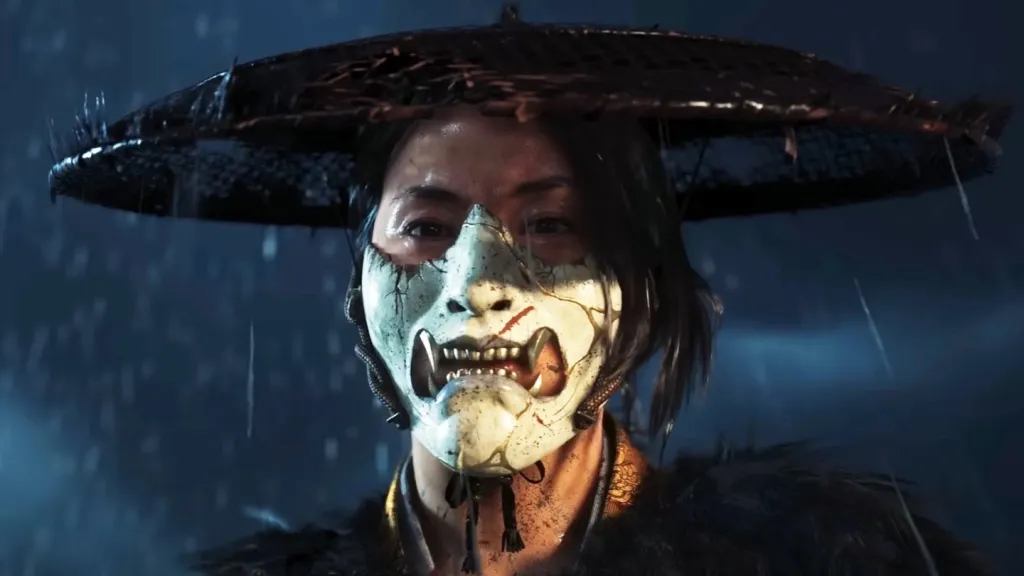
What happens when the flames of rage consume your soul well past your breaking point? Sucker Punch’s latest video game, Ghost of Yōtei, aims to answer that question and then some in a well-crafted tale of bloodlust and revenge. Sucker Punch’s latest Japanese-influenced action-adventure game, which takes place nearly 300 years after Ghost of Tsushima, follows Atsu (Erika Ishii), a spitfire swordswoman who witnessed the horrific murder of her family members at a young age. Thriving on the pain of that loss, Atsu sets herself off on a mission to kill the Yōtei Six, a group of formidable outlaws, responsible for the crime.
Here, Deadline speaks to Sucker Punch’s lead writer Ian Ryan and co-creative director Jason Connell about bringing a new Ghost game to life, new game mechanics and the challenge of crafting sympathy for a lady set on vengeance.
DEADLINE: I would imagine that somewhere along the way of trying to see what the next Sucker Punch project would be, you all thought of making a direct sequel to Ghost of Tsushima. But then that turned into Ghost of Yōtei. Walk us through that process. When did things solidify for you all?
JASON CONNELL: It’s hard. It’s certainly a gift to be able to create a game and then have it be well-received. Games are challenging to make, and certainly trying to make good ones can be pretty tough too. In making Ghost of Tsushima, we’re all excited and proud. However, you don’t know how something will be received until it’s released. Then Tsushima got out there, and people enjoyed all the different aspects of the game. When you go off and try to make something new, and whatever you’re going to make next, you carry this extra creative burden that you have to try to unpack and understand. But that’s a truly great problem to have. You have to figure out what you want to carry forward and that can present a tough creative problem.What we did was try to distill Ghost down into parts that we knew we would carry forward in any Ghost experience. Things like the type of lethal combat or the film-inspired essence of the game, or nature as a balancing vibe against the violent nature of the game, or surrounding ourselves with cultural advisors, which is something we didn’t have to do before [on our previous titles]. All of these things have to be carried over.
What was cool once we had done that, then we’re like, OK, well that leaves us room [to expand]. We like origin stories. If you look back on our other games, you’ll see that. We can pick a new place that matches a character or embellishes a character’s story. So, it went from there by distilling the Ghost IP so that way we could make sure whatever we created was authentic and gave us a lot of room to create Atsu’s story inside of Ezo.
DEADLINE: Ian. So, you hear Ghost of Yōtei is supposed to feature a female protagonist who is exacting revenge in Northern Japan. What are some of the first things you think about when you start conceptualizing this new venture?
IAN RYAN: One of the first things that excited me was the ability to create a new hero character and really define who this person would be. I looked back at what worked so well with Ghost of Tsushima and Jin Sakai’s character. He was a hero who really did overcome so much adversity and triumphed over even death to become a legend in something bigger than himself. So, feeling really passionate about it, we wanted to create someone who could also do something like that, but in a new and interesting way. We challenged ourselves to think about a character that we could craft that would have a more personal story, which we found with the theme of revenge. Then we could also tell the underdog story, which we wanted to go at hard with Atsu to create somebody who was outside the conventions of society at this time to prove herself and overcome even more than Jin Sakai did in order to become this legend that everybody knows about [a.k.a] the Ghost of Yōtei.
DEADLINE: Why was the 1600s the best era for this story?
CONNELL: We like to take inspiration from different points of history. And once we started looking beyond the edge of Japan and the far North, [we started drawing inspiration from] Unforgiven [directed by Lee Sang-il], which was shot in Hokkaido. It really showcased a part of Japan in a way that was not common in older films, but it was exciting, dangerous and wild. It also had all these cool samurai. There were also all these big, interesting landscapes. So, we began examining that time period, and it marks the start of a significant period of change in Japanese history. You have the battle of Sekigahara and then the ushering in of the early Edo period. You’ve got these warriors from the South who would be asked to put down their swords [and live normal lives], and they’re like, “No, I’m not going to.” So, they went up North looking for a new opportunity. We found that interesting and inspiring as storytellers to jump off and try to craft and curate our own mix of what an interesting story could be.
Additionally, there aren’t many contemporary video game worlds set in that region, especially during this time period. So that gave Sucker Punch even more passion with that opportunity. That really helped us land where we landed.
DEADLINE: Which came first, the concept of the Yōtei Six or The Wolf Pack?
CONNELL: Ian’s job is to craft this really big emotional tale with a big arc. Nate [Fox] and I, our job is usually to think top-level about what we think we can achieve and what would be a grand, top-level narrative that would be inspiring for the kinds of mechanics, game world, and vibe that we need. In the early days, I don’t recall if it started off as just six members. It was more akin to the concept of a gang of outlaws, such as The Hateful Eight, for example. It was an interesting concept to wrap our heads around. And it’s a very easy thing for players to wrap their heads around by having six targets.
Our games are so massive, and they have a lot to ask of you as a player, whether it’s narrative or player comprehension or all the cool mechanics and things you can do. There’s a benefit to having a very simple and easy-to-understand concept of what the narrative is. If it goes really complex, that’s beautiful and amazing, and it’s what the game should do. But telling a classical vengeance tale is pretty grabby, and it’s very easy to understand. So knew at some point to stick with having a simple set of targets upfront and vengeance being early on.
RYAN: Yeah, I remember starting with all that and the fact that the Yōtei Six were these targets that required Atsu to hunt and explore these characters in a nonlinear fashion, which was something that really drove our thinking early on. The Wolf Pack came out of that because looking at Atsu’s story and the journey she was going to go on, we knew that we needed that early visceral, passionate revenge drive that she needed to avenge her family. Over the course of the story, we wanted to grow and add dimension to that, and also show why she wants revenge. Ultimately, she wants it to heal herself and reconnect with the parts of herself that she’s lost. So, the Wolf Pack becomes a way for her to step outside of her skin while hunting the Yōtei Six to get revenge, and to see the world through different perspectives, and to reconnect with people and to really heal those parts of her. These two parts of her became such a central source of tension in Atsu’s growth throughout the story.
DEADLINE: Jin’s story was about a big Mongolian invasion of the island, where he had to build an army to help him defeat it. Atsu’s story is much more intimate, where she’s not trying to necessarily save all of Ezo. She’s trying to avenge her family first, and then if Ezo benefits from it, so be it. From a writing standpoint, how did your approach to Atsu differ from Jin’s? What were some non-negotiables that Atsu had to have?
RYAN: It was an exploration to find Atsu and to really find what was going to work. So, we found non-negotiables in that we wanted to lean into the spirit of Toshiro Mifune’s Yojimbo, the wandering samurai. We also collaborated with Atsu’s voice actor, Erika Ishii, to identify what was working and the key aspects of the character. We wanted to bring out two big things early on, where we knew we wanted her to have her guard up because of the pain she’d been through and everything she’d suffered. She has not been trusting of many people [since the murder of her family], and she’s prepared to be hurt again, so she doesn’t want that to happen. In the game, she’s set out to do everything she can to stop that from happening.
But at the same time, especially in a game that’s as long as this one, with the open world experience that’s so vast and that features all these different experiences, we wanted to give her these moments of empathy and humanistic connection with characters, even while her guard may be up. One of the core elements we had to achieve was striking a balance of seeing her on the defensive, especially early on, but then finding moments for her to connect with someone or relate to another victim and want to help them. This dynamic brings her to life and shows the dimension of Atsu.
DEADLINE: Jason, there’s a lot going on stylistically. There’s biodiversity in the different areas, from the Sumi-e ink wash paintings to foraging for mushrooms and fish to the Ainu culture. Talk more about your hands-on experience in Hokkaido that made you bring it to life in the game.
CONNELL: One of the essential parts of making a Ghost game is surrounding yourself with advisors in different capacities that help us understand the culture, mannerisms, religion, art, music and beyond. We learned that on Tsushima. We went with that again on Yōtei, and some of the same actual advisors we had last time. One significant new addition was that we brought on an Ainu advisor from the people of the Ainu. That was instrumental early on and really gave us an idea of what we were trying to create, because none of us knew a lot about the Ainu people. So, we developed a relationship and then went on a research trip to visit areas in Hokkaido.
We visited the place where our Ainu advisor lives and met their mother and other family members. They also run the Ainu Museum, so we saw that, which was really cool. Then they took us foraging in a nearby mountain with this valley and showed us all the plants we could find. So, for about an hour or two, we just walked around and talked about life, as well as which plants were poisonous and which weren’t. Then we’d go back and cook everything and eat lunch together. There were so many interesting Ainu stories and folk legends. We were inspired by a wide range of things, from artwork and foraging to the environment, which motivated us to do our best.
DEADLINE: I am curious as to the change from the Tsushima Resolve name to the Yōtei Spirit gauge.
CONNELL: Yeah, that’s a change we did pretty early on. We think it fits what Atsu is going through. We named it Spirit because we felt it was the spirit of something else within her, fighting and gaining momentum to try again, or building up momentum to try again, and using that spirit. When we were discussing the wolf, I think of it as a spirit animal and guide. The wind is a spirit-nature [symbol] and also a guide, but the spirit within her is the thing that’s building over time. We thought depicting that is important, even if the system functions somewhat similarly, because it’s a sequel. We wanted to provide the contextual narrative reasons why we chose a name that was personal to her.
DEADLINE: I think about Atsu’s quote, where she says, “I don’t know who I am without this anger.” You’ve talked about how this is much more than a revenge tale, so what would you like people to take away from this game in the Ghost series?
CONNELL: When it comes to story, there’s a whole bunch of different types of people and players that we think about. But when it comes to the takeaways from the feelings of the story, it’s hard to make a relatable story out of something that takes place in the 1200s or the 1600s. It’s one of the challenges that Ghost of Tsushima and Ghost of Yōtei bring. I think the writing team has done a good job of both those games in trying to present relatable themes. So, while I hope that no one who plays our game has had to deal with any direct linkage to the trauma that our characters deal with, I do like the fact that it’s relatable that people get trapped in corners about certain things that happen to them.
People get into spots where they’re damaged after traumatic events happen to them. A place where you virtually see no way to solve the issue except for the one that you’ve built in your head. And maybe that is self-destructive. But there are other paths and other people. Finding people in your life is a great way to healing. If people play the story and find a new family to help them work their way through hard problems, that would be awesome. Surrounding yourself with people who love you is important. It’s in the essence of the stories. A lone world finds a new wolf pack. It’s hard to find your wolf pack sometimes in life, and so I think it’s inspiring that she managed to find it despite what happened to her.
RYAN: It’s exactly that. We’ve all been hurt in some ways. So, asking ourselves how we can heal and recover and look outside ourselves and connect with people around us to help us get there to find our wolf pack.
[This interview has been edited for length and clarity]



